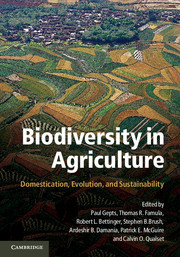Book contents
- Frontmatter
- Contents
- Tables
- Figures
- Foreword
- Contributors
- Acknowledgments
- Introduction: The Domestication of Plants and Animals: Ten Unanswered Questions
- 1 The Local Origins of Domestication
- Section I Early Steps in Agricultural Domestication
- 2 Evolution of Agroecosystems: Biodiversity, Origins, and Differential Development
- 3 From Foraging to Farming in Western and Eastern Asia
- 4 Pre-Domestic Cultivation during the Late Pleistocene and Early Holocene in the Northern Levant
- 5 New Archaeobotanical Information on Plant Domestication from Macro-Remains: Tracking the Evolution of Domestication Syndrome Traits
- 6 New Archaeobotanical Information on Early Cultivation and Plant Domestication Involving Microplant (Phytolith and Starch Grain) Remains
- 7 How and Why Did Agriculture Spread?
- 8 California Indian Proto-Agriculture: Its Characterization and Legacy
- Section II Domestication of Animals and Impacts on Humans
- Section III Issues in Plant Domestication
- Section IV Traditional Management of Biodiversity
- Section V Uses of Biodiversity and New and Future Domestications
- Index
- References
7 - How and Why Did Agriculture Spread?
Published online by Cambridge University Press: 05 June 2012
- Frontmatter
- Contents
- Tables
- Figures
- Foreword
- Contributors
- Acknowledgments
- Introduction: The Domestication of Plants and Animals: Ten Unanswered Questions
- 1 The Local Origins of Domestication
- Section I Early Steps in Agricultural Domestication
- 2 Evolution of Agroecosystems: Biodiversity, Origins, and Differential Development
- 3 From Foraging to Farming in Western and Eastern Asia
- 4 Pre-Domestic Cultivation during the Late Pleistocene and Early Holocene in the Northern Levant
- 5 New Archaeobotanical Information on Plant Domestication from Macro-Remains: Tracking the Evolution of Domestication Syndrome Traits
- 6 New Archaeobotanical Information on Early Cultivation and Plant Domestication Involving Microplant (Phytolith and Starch Grain) Remains
- 7 How and Why Did Agriculture Spread?
- 8 California Indian Proto-Agriculture: Its Characterization and Legacy
- Section II Domestication of Animals and Impacts on Humans
- Section III Issues in Plant Domestication
- Section IV Traditional Management of Biodiversity
- Section V Uses of Biodiversity and New and Future Domestications
- Index
- References
Summary
My book First Farmers (Bellwood 2005) contains my interpretation of the impact of food production on the world-wide distribution of human variation – archaeological, linguistic and biological – as visible at the regional appearances of historical records and prior to the massive population relocations of the past 500 years. The book contains a central theory about the relationships between increasing dependence upon food production, human demography, and population dispersal with farming cultures and languages in train. In it, I evaluate data from archaeology, linguistics, and genetics as independent lines of evidence focused on three central questions: why did farming societies come into existence in prehistory; where, when, and how did they originate in geographical terms; and by which mechanisms and in which directions, did they spread?
Concerning the latter question, which will be the main focus of this chapter, I infer that increasing dependence on food production led to upward trends in population density, and ultimately to population dispersal as early farmers came to depend more and more upon agriculture and animal husbandry for their subsistence, in a world that was still very much the preserve of lower-density hunter–gatherers and still unravaged by the high-population-density diseases of more recent history. However, agricultural dependence was not necessarily an instant result of agricultural origin, and in some cases the two might have been separated across several millennia in time by a period of pre-domestication cultivation and husbandry, as documented by current research in the Levant and China (see Chapters 4, 5, and 9, this volume).
- Type
- Chapter
- Information
- Biodiversity in AgricultureDomestication, Evolution, and Sustainability, pp. 160 - 189Publisher: Cambridge University PressPrint publication year: 2012
References
- 3
- Cited by



